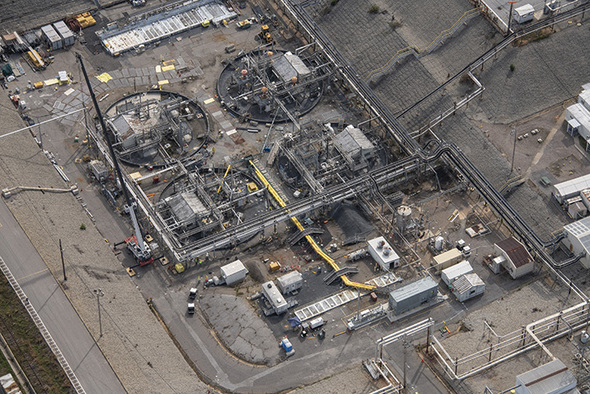“Ethical Markets has been tracking on our annual Green Transition Scoreboard® reports (free downloads at www.ethicalmarkets.com), not only progress in shifting finance from 19th and 20th century fossilized and nuclear energy to cleaner, knowledge-richer, green economies worldwide, but also the multi billions of horrendous social and environmental costs and waste, which were allowed in obsolete accounting models to be “externalized” from corporate and government balance sheets.
This report for the US Department of Energy contains vivid pictures of these “externalities”, and reports on what all this cleanup from past mistakes is still costing taxpayers. These costs will continue for decades …over-hanging our future progress in ramping up investments in a real “moonshot” GREEN NEW DEAL! All financial models must internalize all such costs up-front to get prices right!
~Hazel Henderson, Editor“

EM Update | Vol. 11, Issue 1 | Jan. 8, 2019
![]()
- Waste Removal for Tank Closure Project Underway at Savannah River Site
- Hanford Team Successfully Installs Tank Farm Barriers
- Los Alamos Contractor Earns 83 Percent of Available Fee in FY18 Period
- West Valley Crews Safely Demolish Vitrification Facility Support Buildings
- Nevada Program’s Contractor Earns 94 Percent of Available Fee in FY18
- EM Reaches Milestone in Deactivation of Paducah’s C-400 Building
- Oak Ridge Employee Achieves Highest Engineering Honor
- ORP Contractor Earns Nearly 98 Percent of Available Fee for One-Year Period
- Crane Weighing 150 Tons to Support Hanford Cleanup for Years to Come
- Hanford Waste Treatment Plant Receives Fuel to Power Utilities
Waste Removal for Tank Closure Project Underway at Savannah River Site

The Tank Closure Cesium Removal project at the H Tank Farm at the Savannah River Site.
AIKEN, S.C. – EM is taking a significant step in the startup of Tank Closure Cesium Removal (TCCR) at the Savannah River Site (SRS).
Crews have initiated salt dissolution, the first phase of TCCR operations, in the waste feed tank for the TCCR process. Low-level salt waste accounts for more than 90 percent of waste in the SRS tank farms.
TCCR is a pilot project designed to accelerate removal of radioactive waste from the SRS underground tanks to support tank closures. Liquid waste contractor Savannah River Remediation (SRR) is tasked with completing this work.
Salt dissolution began with the addition of 150,000 gallons of water to Tank 10, signifying the start of bulk waste removal efforts — the first phase of tank closure and a federal facility agreement milestone. A recirculating system, installed on the tank by the TCCR project, uses the water to dissolve the solid salt waste in the tank, called saltcake.
Crews will sample, analyze, and verify chemical constituents in the dissolved salt waste before sending it to the TCCR process enclosure for cesium removal.
Initiating salt dissolution is a major preparation step prior to commissioning TCCR, according to Jim Folk, DOE-Savannah River assistant manager for waste disposition.
“Tank Closure Cesium Removal startup continues to be a priority for EM,” Folk said. “It is expected to be an innovative addition to the waste treatment process.”
![]()
The exterior of the Tank Closure Cesium Removal process enclosure.
TCCR is a waste treatment technology that uses filters, ion exchange columns, and a specially engineered resin to remove cesium — a radioactive chemical element — from the salt waste.
Preparing for salt dissolution included replacing the transfer pump, installing new transfer lines and radiological shielding, deploying in-tank cameras, and completing modifications to allow for leak detection.
Workers completed TCCR pre-commissioning activities, such as safety basis implementation, procedure development, and operator training. Additional work, such as final safety verifications and preparing the ion exchange columns for hot operations, continues.
-Contributor: Colleen Hart
>
Hanford Team Successfully Installs Tank Farm Barriers
![]()
RICHLAND, Wash. – EM’s Office of River Protection (ORP) and tank farms contractor Washington River Protection Solutions (WRPS) recently finished installing two interim surface barriers in Hanford’s SX Tank Farm.
The two barriers cover nine tanks and portions of three more in the tank farm. The barriers consist of a layer of gravel covered with four inches of compacted high-density asphalt. Crews used about 4,500 tons of gravel and 3,300 tons of asphalt covering about 170,000 square feet.
About 300 people worked on the project, including engineers, project management professionals, construction crews, health physics technicians, industrial hygiene personnel, nuclear chemical operators, and employees from several support organizations.
“We could not have done it without so many people working together,” said Jeff Jansen, WRPS project manager. “Their efforts to complete the job safely and efficiently while dealing with changing conditions and time restrictions have been recognized not only by WRPS management, but also by ORP and the state (Department of Ecology).”
Surface barriers are temporary structures constructed under terms of the Tri-Party Agreement and will remain in place until a final farm closure plan is determined.
The barriers play a critical role in protecting the environment by preventing rain and snowmelt from intruding into the underground tanks and percolating into the soil and driving contaminants toward groundwater. They improve the tank and soil stability, significantly reduce surveillance and maintenance costs, and create a clean and stable platform for field crews doing work in the tank farm.
The SX farm, located in Hanford’s 200 West Area, contains 16 tanks, each with a capacity of 1 million gallons. It is the third Hanford tank farm to have surface barriers, joining the T and TY farms. The barrier in T farm, constructed in 2008, covers all or part of nine of the farm’s 16 tanks. The TY farm barrier, completed in 2011, covers its six tanks. The SX farm barriers are similar in design to the TY farm barrier.
-Contributor: Mark McKenna
